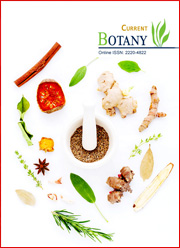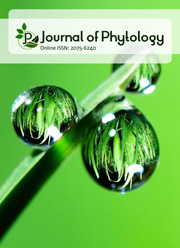Allelopathic potential of Lathyrus aphaca L. on seedling growth of Triticum aestivum L.
DOI:
https://doi.org/10.25081/cb.2025.v16.9204Keywords:
Allelochemicals, Weeds, Growth, Aqueous extracts, MetabolitesAbstract
The allelopathic substances released into the environment from plants inhibit various physiological processes. These allelopathic secondary plant metabolites attract or repel and stimulate or poison other organisms. In the present investigation, the allelopathic potential of a common weed, Lathyrus aphaca, was studied on the seedling growth of wheat (Triticum aestivum L. cv. Dara). The seedling growth was monitored under the different dilutions of L. aphaca extract with water. Control seedlings were grown in distilled water only, i.e., without extract. It was found that the growth and biomass accumulation were significantly suppressed. The aqueous extract of L. aphaca was analyzed through LCMS and revealed the presence of several allelochemicals, viz. 2,4,6-tetrahydroxychalcone, 3-iodo-benzoic acid, p-coumaric acid, kynurenic acid, fumaric acid, sebacic acid, caffeic acid, and ferulic acid, proving the allelopathic potential of the weed.
Downloads
References
Aamir, M., Khan, E. A., Baloch, M. S., & Aslam, M. (2019). Germination Ecology of Lathyrus aphaca, a Problematic Weed of Wheat Crop under Semi-Arid Conditions of Pakistan. Planta Daninha, 37, e019185755. https://doi.org/10.1590/S0100-83582019370100048
Bitencourt, H. R., Santos L. S., & Filho A. P. S. S. (2007). Allelopathic activity of synthetic chalcone, its precursors and of related ketones and aldehydes. Planta Daninha, 25(4), 747-753. https://doi.org/10.1590/S0100-83582007000400011
Cheng, F., & Cheng, Z. (2015). Research Progress on the use of Plant Allelopathy in Agriculture and the Physiological and Ecological Mechanisms of Allelopathy. Frontiers in Plant Science, 6, 1020. https://doi.org/10.3389/fpls.2015.01020
Chinard, F. (1952). Photometric estimation of proline and ornithine. The Journal of Biological Chemistry, 199(1), 91-95. https://doi.org/10.1016/S0021-9258(18)44814-4
ICAR. (2013). Retrieved from https://www.icar-crida.res.in/CP/Uttar_Pradesh/UP30_Balrampur_28.12.13.pdf
Kaur, H., Inderjit, & Kaushik, S. (2005). Cellular evidence of allelopathic interference of benzoic acid to mustard (Brassica juncea L.) seedling growth. Plant Physiology and Biochemistry, 43(1), 77-81. https://doi.org/10.1016/j.plaphy.2004.12.007
Kong, C.-H., Li, Z., Li, F.-L., Xia, X.-X., & Wang, P. (2024). Chemically Mediated Plant–Plant Interactions: Allelopathy and Allelobiosis. Plants, 13(5), 626. https://doi.org/10.3390/plants13050626
Kong, C.-H., Xuan, T. D., Khanh, T. D., Tran, H.-D., & Trung, N. T. (2019). Allelochemicals and Signaling Chemicals in Plants. Molecules, 24(15), 2737. https://doi.org/10.3390/molecules24152737
Kostina-Bednarz, M., Płonka, J., & Barchanska, H. (2023). Allelopathy as a source of bioherbicides: challenges and prospects for sustainable agriculture. Reviews in Environmental Science and Bio/Technology, 22, 471-504. https://doi.org/10.1007/s11157-023-09656-1
Li, J., Zhao, T., Chen, L., Chen, H., Luo, D., Chen, C., Miao, Y., & Liu, D. (2022). Artemisia argyi allelopathy: a generalist compromises hormone balance, element absorption, and photosynthesis of receptor plants. BMC Plant Biology, 22, 368. https://doi.org/10.1186/s12870-022-03757-9
Mushtaq, W., Ain, Q., Siddiqui, M. B., & Hakeem, K. R. (2019). Cytotoxic allelochemicals induce ultrastructural modifications in Cassia tora L. and mitotic changes in Allium cepa L.: a weed versus weed allelopathy approach. Protoplasma, 256, 857-871. https://doi.org/10.1007/s00709-018-01343-1
Turk, M. A., & Tawaha, A. M. (2003). Allelopathic Effect of Black Mustard (Brassica nigra L.) on Germination and Growth of Wild Oat (Avena fatua L.). Crop Protection, 22(4), 673-677. https://doi.org/10.1016/S0261-2194(02)00241-7
Ujala, A. (2024). Retrieved from https://www.amarujala.com/uttar-pradesh/balrampur/wheat-production-decreased-by-10560-quintals-in-four-bighas-balrampur-news-c-99-1-brp1003-108790-2024-04-16
Xiao, Y., Tan, J., Yu, Y., Dong, J., Cao, L., Yao, L., Zhang, Y., & Yan, Z. (2024). Phytotoxic Effects and Potential Allelochemicals from Water Extracts of Paulownia tomentosa Flower Litter. Agronomy, 14(2), 367. https://doi.org/10.3390/agronomy14020367
Published
How to Cite
Issue
Section
Copyright (c) 2025 Mohammad Akmal

This work is licensed under a Creative Commons Attribution-NonCommercial 3.0 Unported License.



 .
.